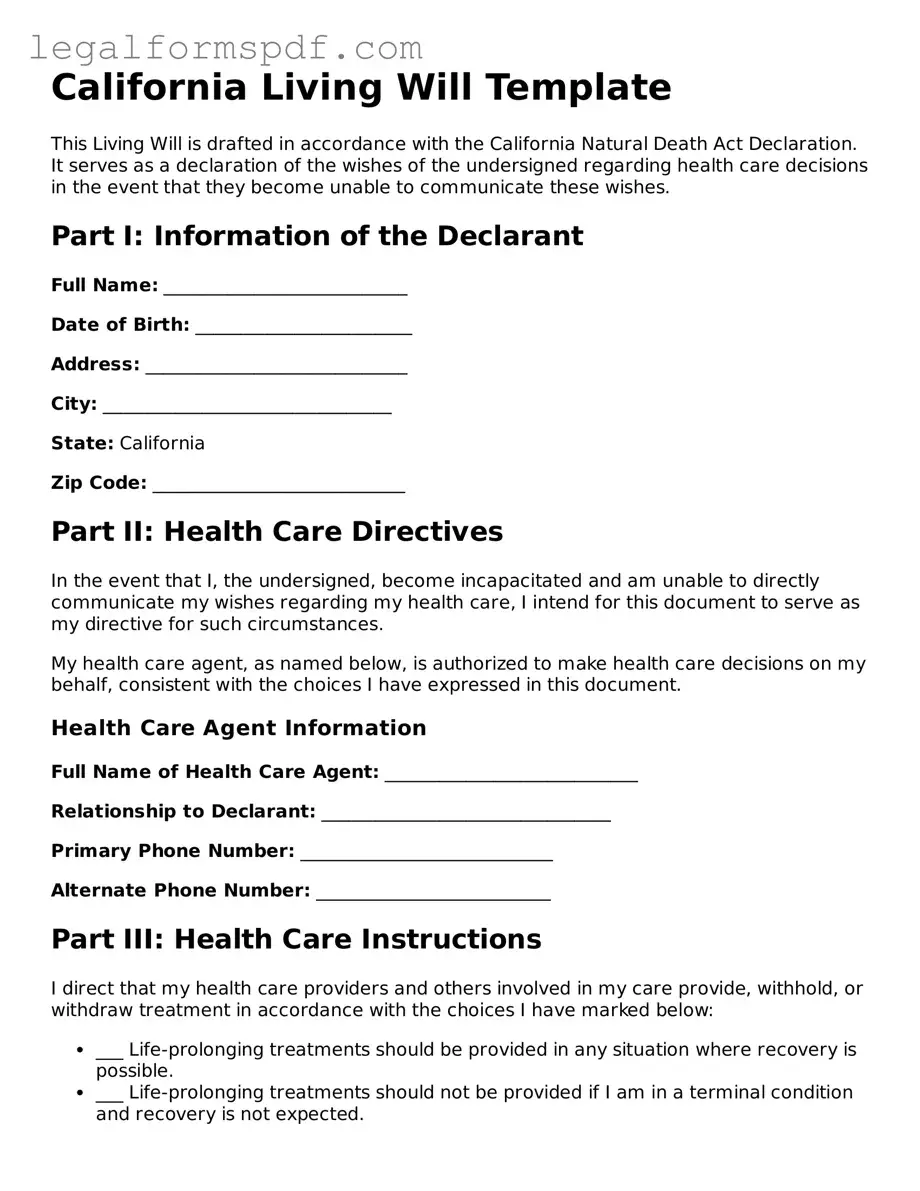California Living Will Template
This Living Will is drafted in accordance with the California Natural Death Act Declaration. It serves as a declaration of the wishes of the undersigned regarding health care decisions in the event that they become unable to communicate these wishes.
Part I: Information of the Declarant
Full Name: ___________________________
Date of Birth: ________________________
Address: _____________________________
City: ________________________________
State: California
Zip Code: ____________________________
Part II: Health Care Directives
In the event that I, the undersigned, become incapacitated and am unable to directly communicate my wishes regarding my health care, I intend for this document to serve as my directive for such circumstances.
My health care agent, as named below, is authorized to make health care decisions on my behalf, consistent with the choices I have expressed in this document.
Health Care Agent Information
Full Name of Health Care Agent: ____________________________
Relationship to Declarant: ________________________________
Primary Phone Number: ____________________________
Alternate Phone Number: __________________________
Part III: Health Care Instructions
I direct that my health care providers and others involved in my care provide, withhold, or withdraw treatment in accordance with the choices I have marked below:
- ___ Life-prolonging treatments should be provided in any situation where recovery is possible.
- ___ Life-prolonging treatments should not be provided if I am in a terminal condition and recovery is not expected.
- ___ Artificial nutrition and hydration (feeding tube) should be provided regardless of my condition.
- ___ Artificial nutrition and hydration (feeding tube) should not be provisioned if I am in a terminal condition.
Part IV: Signature
This document is executed by me, the undersigned Declarant, as my Living Will, on this date:
Date: ___________________________
Signature of Declarant: ___________________________
Print Name: ___________________________
Part V: Witnesses
This Living Will must be signed by two witnesses who are adults and who are not related to the Declarant by blood, marriage, or adoption. Neither of the witnesses should be a beneficiary of the Declarant's estate, a creditor of the Declarant, or have any claim against the Declarant's estate.
- Witness 1
Full Name: ___________________________
Signature: ___________________________
Date: _______________________________
- Witness 2
Full Name: ___________________________
Signature: ___________________________
Date: _______________________________
Part VI: Acknowledgment of Notary Public
If required or desired, a Notary Public can acknowledge the signing of this document. This acknowledgment verifies the identity of the Declarant and the witnesses.
State of California
County of ________________________
On ________________________ (date), before me, (___________________), a Notary Public, personally appeared _____________________________, who proved to me on the basis of satisfactory evidence to be the person(s) whose name(s) is/are subscribed to the within instrument and acknowledged to me that he/she/they executed the same in his/her/their authorized capacity(ies), and that by his/her/their signature(s) on the instrument the person(s), or the entity upon behalf of which the person(s) acted, executed the instrument.
Witness my hand and official seal
Signature of Notary Public: ___________________________
(Seal)
